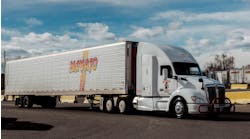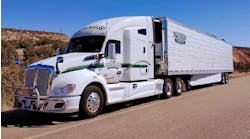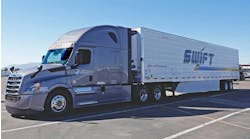Fleet renewal boosts distribution efficiency, productivity for Hollandia Dairy
EVERY day during the school year, hundreds of thousands of children in Southern California enjoy a carton of cold milk with lunch. For many, that milk comes from Hollandia Dairy.
Produced by cows at the Hollandia dairy farm in San Jacinto, the milk then is transported in sanitary milk tankers to the Hollandia Dairy processing plant in San Marcos. Once processed and packaged, the milk is transported by the Hollandia Dairy refrigerated truck fleet to the dairy’s customers, including retail, schools and other institutions.
Since 1950, Hollandia Dairy has provided milk, along with juice and cultured products, to the families of Southern California. The company was founded by the de Jong family, who emigrated from Holland and instilled a strong work ethic in the operation.
That work ethic keeps the company’s 49 refrigerated straight trucks and 10 tractor-trailer rigs on a tight schedule, making customer deliveries across an enormous geographic area. The fleet operates in one of the most congested geographic areas in the country.
Many schools
“We deal with a lot of schools, and it’s important to meet our delivery windows,” says Patrick Schallberger, chief executive officer of Hollandia Dairy. “Our trucks face intense driving conditions in the city while they are making 20 to 30 stops a day. Truck and refrigeration unit reliability are crucial.
“Bobtail routes cover 100 to 120 miles a day, and we double-shift our newest trucks to maximize productivity. Customers typically want deliveries before the start of school in the morning. We make a lot of deliveries in late afternoon and at night.
“Our refrigerated tractor-trailer rigs serve the big-box stores (typically three stops per shift) during the day, followed by relay runs to our Norco, California, branch.”
In the past, the dairy tried to squeeze maximum value and life out of the fleet by running refrigerated straight trucks for 10 to 12 years. After reviewing fleet productivity, Fleet Manager Leo Rose decided it was time to try a different approach.
In 2016, he approached corporate management with a plan to completely update the distribution fleet.
The plan included replacing the existing fleet with higher-quality trucks and adopting a shorter seven-year replacement schedule.
It turned out to be an easy sell, and Hollandia Dairy elected to replace the existing refrigerated straight trucks with Kenworth T370s. “We ran the numbers, and the T370 made a lot of sense—the purchase price, reliability and productivity, maintenance costs and easy access to engine parts, expected fuel-economy advantages and resale value,” Rose says. “We’re already seeing better fleet utilization that is averaging 95% to 96%. The industry average is 91%.”
Happy drivers
The benefit of the fleet update went beyond the company’s bottom line. “Like other companies with distribution fleets, it has become more challenging for us to find drivers,” Rose says. “Most of our drivers are in their mid-20s to mid-30s.
“This is a physical job, and drivers appreciate having a more comfortable work environment. Our drivers are very happy with the new trucks, and favorable feedback has been through the roof. We’ve added a host of new comfort options, and it’s been all thumbs-up for those behind the wheel.”
The T370s were Cummins ISB 6.7 engines rated for 285 horsepower, and Hollandia Dairy worked closely with Inland Kenworth-El Cajon to trim as much tare weight as possible. “We went with Allison 2000 automatic transmissions, aluminum fuel tanks, aluminum cross members and aluminum wheels,” Rose says. “Reducing weight means more milk to haul. We also chose an air suspension for the drive axles and disc brakes.”
Allison transmissions were chosen for more than just lower weight. Allison fully automatic transmissions feature Continuous Power Technology, which provides more power to the wheels, leading to quicker route times, higher average speeds and more miles per day.
Cummins said it was proud to partner with Hollandia Dairy on the fleet renewal project to provide power to a fleet that always is on. “Hollandia Dairy fleet manager Leo does an excellent job maintaining vehicles for top performance, and we look forward to continuing our support as they add natural gas engines to their diesel fleet,” the company said.
Reefer bodies
The T370s are outfitted with Supreme 22-foot Kold King XL reefer bodies and Thermo King 880R refrigeration units, which are fully certified by the California Air Resources Board. Body interiors are spec’d for dairy distribution service with flat aluminum floors and 3-foot-high corrugated scuff rails.
On the outside, the dairy operation moved away from decals in favor of replaceable sign-boards from Kwik Zip. Hollandia Dairy specifies Whiting and Todco rollup doors and Maxon rear liftgates with Purkey’s direct liftgate charging system.
For fleet monitoring to ensure compliance with the Food and Drug Administration’s Safe Food Transport regulations, Hollandia Dairy selected Samsara’s telematics system.
“We constantly monitor the temperature for every load,” Rose says. “Samsara provided the Wi-Fi sensors in the cargo area, and the temperature data is transmitted to the cloud. For the time being, we are keeping that data indefinitely.
“We’ve been getting regular audits from the FDA and other agencies for quite awhile. Some customers also inspect our trucks and trailers prior to product delivery. We’re happy with all of that. Our corporate goal is to always exceed the regulations.”
Kiren Sekar, vice president of product at Samsara, adds: “We’re thrilled to support Hollandia Dairy’s fleet with a complete management platform including hours of service, location tracking, dashboard cameras for fleet safety and live temperature monitoring. Through our intuitive HOS solution, we’re committed to helping our customers more easily meet the demands of the federal electronic logging device mandate. Meanwhile, with Samsara’s real-time alerts and searchable historical temperature reports, we’re proud to be part of helping Hollandia ensure product quality and compliance with the latest food safety monitoring regulations.”
As part of its fleet upgrade effort, Hollandia Dairy recently added Kenworth’s T680 to its mix and plans to standardize that model as its other tractors are traded out. “We’ve seen a jump of one mile-per-gallon in fuel economy with the T680s,” says Rose. “We’ll run those about 140,000 miles a year, so the savings will really add up.”
For refrigerated trailers, Hollandia Dairy buys pre-owned 53-ft units that are as close as possible to a dairy spec. These are cut down to 48- or 36-ft-long trailers, and they get new Thermo King S-600 refrigeration units. Liftgates are installed on about three-fourths of the trailers.
“We look for refrigerated trailers that are five to seven years old,” Rose says. “The refrigeration units are evergreen models under the CARB rules.”
Natural gas
On the power side, still more fleet changes are coming. Hollandia Dairy qualified for grants from CARB and the local Air Pollution Control District for 11 natural gas-fueled trucks (eight straight trucks and three tractors) to be added over the next two years.
The grants provide $100,000 per straight truck and $125,000 per tractor. A secondary grant from the US Department of Energy will provide $20,000 per straight truck and $25,000 per tractor.
Hollandia Dairy selected the 285-hp Cummins ISL-G 9-liter engine for the straight trucks. Two-axle tractors were selected for the grants, and they will be powered by the Cummins ISM-G rated for 325 horsepower.
The dairy distribution straight trucks, which average about 35,000 miles per year, are operated in both single and double shifts. The first shift departs the Hollandia Dairy facility at 2 am, and drivers typically make 25 stops, with up to 14,000 pounds of product aboard. About 20% of the trucks then go out for a second shift once the first shift returns around noon.
Class 8 tractors are used to move product to big-box stores (typically three stops per shift), plus they haul 48-foot trailers to their northern branch, about 90 miles north of Hollandia’s headquarters, where they cross-dock and cross-load more than a dozen medium-duty trucks for deliveries. “This operation has allowed us to expand in other markets by using our trucks as distribution centers,” says Rose.
At the end of each shift, truck body and trailer cargo areas are cleaned out with a pressure washer. “We have a dedicated employee assigned to the clean-out process,” Rose says. “In addition to the daily rinse-out, we wash and sanitize each vehicle at least once a month, and we swab and test the interior surfaces after each sanitizing.”
The Hollandia Dairy fleet shop handles almost all of the non-warranty maintenance on the fleet. The primary focus is on preventive maintenance, and mechanics replace any component they believe will not last another 90 days. The shop was updated to ensure that the maintenance team can safely service the new natural gas-fueled trucks.


